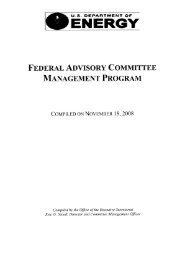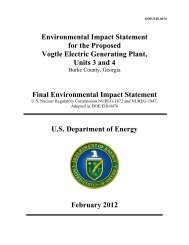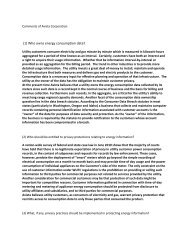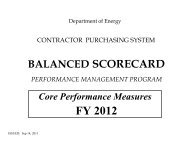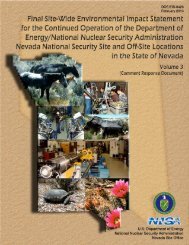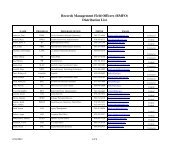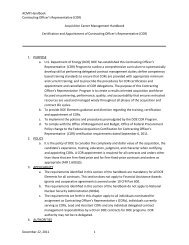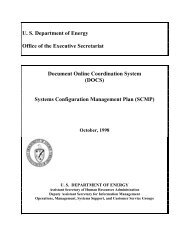U.S.-India Partnership to Advance Clean Energy: A Progress Report
U.S.-India Partnership to Advance Clean Energy: A Progress Report
U.S.-India Partnership to Advance Clean Energy: A Progress Report
Create successful ePaper yourself
Turn your PDF publications into a flip-book with our unique Google optimized e-Paper software.
U.S.-INDIA PARTNERSHIP TOADVANCE CLEAN ENERGY(PACE)A PROGRESS REPORTU.S. DEPARTM ENT O FJUNE 2012
The U.S.-<strong>India</strong> <strong>Partnership</strong> <strong>to</strong> <strong>Advance</strong> <strong>Clean</strong> <strong>Energy</strong>PACE - RResearchJoint <strong>Clean</strong> <strong>Energy</strong> Research andDevelopment Center: initial priorityareas in solar energy, buildings efficiency,and second generation biofuels.PACE - DDeploymentEfficiency, renewable energy, cleanerfossil technology, clean energyplanning, engaging the private sec<strong>to</strong>r,and mobilizing investment.U.S.-INDIA PARTNERSHIP TO ADVANCE CLEANENERGY (PACE)A PROGRESS REPORTBY THE U.S. DEPARTMENT OF ENERGY, U.S. DEPARTMENT OF STATE, U.S. AGENCY FORINTERNATIONAL DEVELOPMENT (USAID), U.S. TRADE AND DEVELOPMENT AGENCY (USTDA),U.S. DEPARTMENT OF COMMERCE, OVERSEAS PRIVATE INVESTMENT CORPORATION (OPIC),AND EXPORT-IMPORT BANK (EX-IM).Pho<strong>to</strong>s courtesy of the Department of <strong>Energy</strong>’s ETVC, the White House, State Department, U.S. Agency forInternational Development, U.S. Trade and Development Agency and Prime Minister of <strong>India</strong> websites (or asotherwise indicated).
EXECUTIVE SUMMARY: U.S.-INDIA PARTNERSHIP TO ADVANCE CLEAN ENERGY (PACE)A PROGRESS REPORT<strong>Energy</strong> cooperation is a central element of theU.S.-<strong>India</strong> strategic partnership. President Obamaand Prime Minister Singh launched the U.S.-<strong>India</strong><strong>Partnership</strong> <strong>to</strong> <strong>Advance</strong> <strong>Clean</strong> <strong>Energy</strong> (PACE) inNovember 2009 <strong>to</strong> accelerate the transition <strong>to</strong> highperforming, low emissions, and energy secureeconomies.Since its inception, PACE has mobilizedsignificant resources from both governments andthe private sec<strong>to</strong>r <strong>to</strong> promote clean energy scale-upand low-carbon growth.STRUCTURE OF COOPERATIONWorking under auspices of the U.S.-<strong>India</strong> <strong>Energy</strong>Dialogue, PACE engages a diverse array of U.S.and <strong>India</strong>n government agencies. On the U.S.Government side, supporting agencies include theU.S. Department of <strong>Energy</strong>, U.S. Agency forInternational Development, U.S. Department ofState, U.S. Trade and Development Agency,Overseas Private Investment Corporation, Export-Import Bank, U.S. Department of Commerce, U.S.Geological Survey and Office of the U.S. TradeRepresentative.PACE has two primary and interlinkedcomponents: clean energy research (PACE-R) andclean energy deployment (PACE-D).PACE-RESEARCHUnder PACE-R, the U.S. Department of <strong>Energy</strong>(DOE) and <strong>India</strong>’s Planning Commissionestablished a Joint <strong>Clean</strong> <strong>Energy</strong> Research andDevelopment Center (JCERDC) in November2010 designed <strong>to</strong> promote clean energy innovationby consortia of scientists and engineers from <strong>India</strong>and the United States.In May 2011, DOE and the Government of <strong>India</strong>each made $25 million available (over five years,subject <strong>to</strong> appropriations) under a joint solicitationfor R&D proposals by consortia in the initialpriority areas of solar energy, buildings efficiency,and second generation biofuels.The U.S. and <strong>India</strong>n prime awardees wereannounced in April 2012 following an extensivemerit-review process. Consortia members havepledged an additional $75 million in matchingprivate funds, for a combined funding <strong>to</strong>tal of morethan $125 million <strong>to</strong> launch R&D cooperationunder JCERDC.DOE’s Office of Policy and International Affairsand the Indo-U.S. Science and Technology Forumare serving as the Secretariat for JCERDC.PACE-DEPLOYMENT (PACE-D)PACE-D is designed <strong>to</strong> tackle multiple cleanenergy deployment opportunities, including:energy efficiency and distribution reform; scalingrenewable energy, cleaner fossil technology andmanagement; clean energy planning; and engagingthe private sec<strong>to</strong>r and mobilizing investment.SIGNIFICANT PROGRESS, SIGNIFICANTOPPORTUNITIESBuilding on a strong legacy of bilateralcollaboration, PACE has already achieved someimportant successes, including the launch of thepotentially transformational joint research effortunder JCERDC. Yet significant opportunities stillremain, and both countries will continue <strong>to</strong> workhard in the months and years ahead <strong>to</strong> continue theshared pursuit of a clean energy future.
PACE IN ACTION: SELECTED HIGHLIGHTS$125 MILLION PUBLIC-PRIVATE JOINT RESEARCH CENTER: In April 2012, both countries announced thefirst consortia awardees under the PACE Joint <strong>Clean</strong> <strong>Energy</strong> Research and Development Center. These jointU.S.-<strong>India</strong>, public-private consortia will dedicate efforts <strong>to</strong>wards the discovery of transformational scientificand technological solutions in the areas of building efficiency, solar energy and advanced biofuels. The Centerwill involve over 95 government, private and university organizations in a $125 million effort over five years.NEW 5-YEAR, $20 MILLION COLLABORATION ON DEPLOYMENT: In June 2012, the U.S. Agency forInternational Development (USAID) launched a new five-year technical assistance program <strong>to</strong> support cleanenergy development and scale up in partnership with the Ministry of Power and the Ministry of New andRenewable <strong>Energy</strong>. The $20 million contract will improve end-use energy efficiency, increase the supply ofrenewable energy, and adopt and accelerate deployment of cleaner fossil fuel technologies. The focus of theprogram will be on strengthening the enabling environment, increasing access <strong>to</strong> finance, and enhancinginstitutional and human capacity.MORE THAN $1.7 BILLION MOBILIZED FOR CLEAN ENERGY FINANCE: The United States has establisheda <strong>Clean</strong> <strong>Energy</strong> Finance Center at the American Center in New Delhi <strong>to</strong> support the financing of cleantechnology, staffed with representatives from the U.S. Department of Commerce, the State Department,USAID, U.S. Trade and Development Agency (USTDA), Overseas Private Investment Corporation (OPIC),Export-Import Bank (Ex-Im), and the U.S. Department of <strong>Energy</strong> (DOE). Since PACE’s inception, theseagencies have mobilized more than $1.7 billion in public and private resources for clean energy projects in<strong>India</strong>.PRIVATE SECTOR ENGAGEMENT: Both countries launched the U.S.-<strong>India</strong> <strong>Energy</strong> Cooperation Program (ECP)in late 2010 <strong>to</strong> better leverage the U.S. private sec<strong>to</strong>r role in clean energy deployment. With support from theU.S. Trade and Development Agency (USTDA) the ECP has grown <strong>to</strong> 16 member companies and has beenable <strong>to</strong> establish strong working channels for government-<strong>to</strong>-business technical and commercial partnershipsand <strong>to</strong> mobilize funding for a growing portfolio of clean energy projects in <strong>India</strong>.STUDY TOURS AND TRADE MISSIONS: USTDA sponsored the <strong>Clean</strong> <strong>Energy</strong> Exchange Program, a series offour reverse trade missions <strong>to</strong> the United States in the areas of smart grid expansion, solar power generation,unconventional gas, and green buildings. Overall, USTDA support for infrastructure feasibility studies, reversetrade missions and other technical assistance in the <strong>India</strong>n market has translated in<strong>to</strong> at least $1.7 billion in U.S.exports.A STRONG BILATERAL PROJECT PORTFOLIO: USTDA has funded feasibility studies and pilot projects forsmart grid implementation with utilities in <strong>India</strong> and private sec<strong>to</strong>r led solar power generation. The two sidesalso continue technical cooperation in support of renewable energy and energy efficiency deployment throughUSAID and DOE and its national labs, including supporting work on solar resource assessment and mapping,solar technologies training for <strong>India</strong>n financial institutions, improved wind resource estimates, data center andIT office building efficiency, and <strong>Energy</strong> Conservation Building Code implementation at the local level.
“Developing and investing in new technologies is a keycomponent <strong>to</strong> meeting the goals of a clean energy future.This innovative approach <strong>to</strong> collaborative research is a testament<strong>to</strong> the special relationship shared by the two countries.By working with our partners in <strong>India</strong> and sharing a strongcommitment <strong>to</strong> building a clean energy economy, we can getfurther, faster, than by working alone.”-- Dr. Steven Chu, U.S. Secretary of <strong>Energy</strong>Announcing the U.S.-<strong>India</strong> Joint <strong>Clean</strong> <strong>Energy</strong> R&D Center(May 16, 2011)
“The cooperation we are forging here should build habits ofcooperation and bonds of trust as we strive <strong>to</strong> make both of ourcountries stronger, more prosperous, and better equipped <strong>to</strong>address the challenges we face.”-- Hillary Rodham Clin<strong>to</strong>nU.S. Secretary of StateU.S.-<strong>India</strong> Strategic Dialogue (July 2011)
PARTNERSHIP TO ADVANCE CLEAN ENERGYRESEARCH
PACE-RESEARCH (PACE-R) OverviewDuring President Obama’s head-of-state visit <strong>to</strong><strong>India</strong> in November 2010, the U.S. Department of<strong>Energy</strong> (DOE) and <strong>India</strong>’s Planning Commissionentered in<strong>to</strong> an Agreement <strong>to</strong> Establish a Joint<strong>Clean</strong> <strong>Energy</strong> Research and Development Center(JCERDC) <strong>to</strong> promote clean energy innovation byconsortia of scientists and engineers from <strong>India</strong>and the United States.JCERDC’s structure is designed <strong>to</strong> encouragepartnerships, leverage additional sources offunding, and engage private sec<strong>to</strong>r companies bestplaced <strong>to</strong> understand the near-term clean energyresearch and development (R&D) needs for abroad, industry-wide impact.PACE-R collaboration under JCERDC representsthe most integrated joint clean energy undertakingDOE has done with any country, including theDepartment’s first-ever joint funding solicitationwith another government.U.S.-INDIA JOINT FUNDING OPPORTUNITYANNOUNCEMENT (JOINT FOA):In May 2011, DOE and the Government of <strong>India</strong>each made $25 million available (over five years,subject <strong>to</strong> appropriations) for work conducted byU.S. and <strong>India</strong>n institutions and individuals underthe first JCERDC Joint FOA for R&D proposals inthe initial priority areas of solar energy, buildingsefficiency, and second generation biofuels. Theprime awardees were announced in April 2012following an extensive merit-review process:• The National Renewable <strong>Energy</strong> Labora<strong>to</strong>ry(NREL) and <strong>India</strong>’s Institute of Science atBangalore in the area of solar energy;•Lawrence Berkeley National Labora<strong>to</strong>ry(Berkeley Lab) and <strong>India</strong>’s Center forEnvironmental Planning and Technology (CEPT)University-Ahmedabad in the area of buildingsefficiency; and•The University of Florida and <strong>India</strong>n Institute ofChemical Technology(IICT)-Hyderabad in thearea of second-generation biofuels.Consortia members have pledged an additional $75million in matching private funds, for a combinedfunding <strong>to</strong>tal of more than $125 million <strong>to</strong> launchR&D cooperation under JCERDC.BREAKTHROUGH PACE RESEARCH WILLADVANCE CLEAN ENERGY DEPLOYMENTUNDER THE U.S.-INDIA ENERGYDIALOGUE AND PACE-D ACTIVITIESSUSTAINABLE CITIES: DOE is sharing models,building guidelines, lessons learned, best practices,as well as other <strong>to</strong>ols and information <strong>to</strong> advance thedevelopment of near-zero urban energy cities andcommunities. Brookhaven National Labora<strong>to</strong>ry(BNL) and Lawrence Berkeley National Berkeley(Berkeley Lab) are working with key partners,including <strong>India</strong>’s Ministry of Urban Development,Ministry of Commerce and Industries, and Ministryof New and Renewable <strong>Energy</strong> (MNRE) <strong>to</strong> advanceplanning and implementation of these cutting-edgeurban planning <strong>to</strong>ols.SOLAR TECHNOLOGY: DOE’s National Renewable<strong>Energy</strong> Labora<strong>to</strong>ry (NREL) collaborates withMNRE’s Solar <strong>Energy</strong> Center (SEC) on solarresource assessments and mapping. The twoinstitutions are also collaborating on the reliabilityof pho<strong>to</strong>voltaic (PV) modules and on minigrids.WIND TECHNOLOGY: NREL collaborates with<strong>India</strong>’s Centre for Wind <strong>Energy</strong> Technology (C-WET) <strong>to</strong> accelerate development of testing facilitiesand deployment of wind energy technologies --improving wind resource estimates, on-shore andoff-shore wind turbine modeling and energytechnology field testing.ADVANCED BIOFUELS: DOE and NREL havecollaborated with MNRE on advanced biofuels,providing technical support <strong>to</strong> the <strong>India</strong>n OilCorporation (IOC) for the development of acellulosic ethanol pilot plant design. Additionalefforts include R&D on jatropha biodiesel for use inon-road transport, as well as jatropha cropdevelopment and testing. DOE’s Argonne Nationallabora<strong>to</strong>ry (ANL) is also collaborating with IIT-Kanpur on the production and evaluation ofbiodiesel fuels from Jatropha and Karanja feeds<strong>to</strong>cks for heavy-duty engine applications.POLICY BEST PRACTICES AND ANALYSIS: DOEand NREL are collaborating with MNRE on thedevelopment of a database <strong>to</strong> catalogue national,state and local incentives and policies for energyefficiency and renewable energy in <strong>India</strong> similar <strong>to</strong>the DSIRE database in the United States.
ormer Ambassador of <strong>India</strong> <strong>to</strong> the United States Meera Shankar andDeputy Secretary Daniel Poneman at the Initialing Ceremony forJCERDC at DOE Headquarters in Washing<strong>to</strong>n (August 2010 )“We are two nations, both of which are committed <strong>to</strong> sustainabledevelopment, both of which are committed <strong>to</strong> assuring a clean andprosperous future for all of our people. And we both face many of thesame challenges <strong>to</strong> developing our energy future.As we move forward <strong>to</strong>gether, we will continue <strong>to</strong> expand our cooperation<strong>to</strong> promote a secure and stable world, <strong>to</strong> advance technology andinnovation, <strong>to</strong> expand mutual prosperity and global economic growth, <strong>to</strong>support sustainable development, and <strong>to</strong> lead the global community inachieving a clean energy future.”-- Daniel PonemanDOE Deputy Secretary of <strong>Energy</strong>
SOLAR ENERGY CONSORTIUMJOINT CLEAN ENERGY RESEARCH AND DEVELOPMENT CENTER (JCERDC)Under JCERDC’s first joint Funding OpportunityAnnouncement (Joint FOA), DOE and theGovernment of <strong>India</strong> will each award $12.5million in financial assistance (over five years) <strong>to</strong>support solar energy R&D by teams of scientistsand engineers from <strong>India</strong> and the United States,subject <strong>to</strong> appropriations.Following a competitive merit-review process, theNational Renewable <strong>Energy</strong> Labora<strong>to</strong>ry (NREL)and <strong>India</strong>’s Institute of Science at Bangalore wereselected <strong>to</strong> lead the U.S. team members and <strong>India</strong>team members, respectively, of a consortiumfocused on the launch of a Solar <strong>Energy</strong> ResearchInstitute for <strong>India</strong> and the United States(SERIIUS).SERIIUS will develop and ready emerging andrevolutionary solar electricity technologies <strong>to</strong>wardthe long-term success of <strong>India</strong>’s Jawaharlal NehruNational Solar <strong>Energy</strong> Mission and DOE’sSunShot Initiative. SERIIUS will carry outfundamental and applied research, analysis andassessment, outreach, and workforce developmentthrough three research thrusts:1. Sustainable Pho<strong>to</strong>voltaics (PV) <strong>to</strong> develop nextgenerationmaterials, devices, and manufacturingprocesses tailored <strong>to</strong> <strong>India</strong>’s needs, environment,and resource availability.2. Multiscale Concentrated Solar Power (CSP) <strong>to</strong>overcome critical science and engineeringchallenges for reliable multiscale (including small25–500 kW) CSP systems.3. Solar Integration <strong>to</strong> identify and assess keytechnical, economic, environmental, and policybarriers <strong>to</strong> enable a research agenda for technicalreadiness in <strong>India</strong> and <strong>to</strong> benefit the United States.Supported by a planned additional cost-share ofapproximately $12.85 million from U.S. consortiummembers, NREL will collaborate with a number ofU.S. partners—which include Sandia NationalLabora<strong>to</strong>ries; RAND Corporation; LawrenceBerkeley National Labora<strong>to</strong>ry; Arizona StateUniversity; Carnegie Mellon University; ColoradoSchool of Mines; Massachusetts Institute ofTechnology; Purdue University; StanfordUniversity; University of Central Florida; Universityof South Florida; Washing<strong>to</strong>n University in St.Louis; Cookson Electronics, Corning Incorporated;General Electric Company; Konarka Technologies,Inc.; MEMC Corporation; and Solarmer <strong>Energy</strong> Inc.Supported by a planned additional cost-share ofapproximately $21 million from <strong>India</strong>n consortiummembers, the <strong>India</strong>n Institute of Science-Bangalorewill collaborate with a number of <strong>India</strong>n partners—which include the <strong>India</strong>n Institute of Technology –Bombay; Center for the Study of Science,Technology and Policy; International <strong>Advance</strong>dResearch Centre for Powder Metallurgy and NewMaterials; Solar <strong>Energy</strong> Centre; <strong>India</strong>n Institute ofTechnology-Madras; <strong>India</strong>n Association for theCultivation of Science; Clique Developments Ltd.;Hindustan Petroleum Corporation Ltd.; Moser Baer<strong>India</strong> Ltd.; Thermax Ltd.; TurboTech Precision;Engineering Ltd.; and Wipro Ltd.
KEY FACTS: Solar <strong>Energy</strong> in<strong>India</strong>With about 300 sunny days a year, <strong>India</strong>’s solarenergy potential is among the best in the world --approximately 5,000 trillion kilowatt hours (kWh)per year incident over <strong>India</strong>’s land area receives anaverage hourly solar radiation of 200 megawatts(MW) per square kilometer.According <strong>to</strong> the <strong>India</strong> <strong>Energy</strong> Portal developed byThe <strong>Energy</strong> and Resources Institute (TERI),approximately 12.5 percent of <strong>India</strong>’s land mass(413,000 square kilometers) receives sufficientradiation <strong>to</strong> generate solar power.<strong>India</strong>’s solar power generation capacity has grownfrom 8 MW in January 2010 <strong>to</strong> over 979 MW as ofMay 2012 (MNRE, <strong>Progress</strong> under JawaharlalNehru National Solar Mission, May 11, 2012).<strong>India</strong>’s Jawaharlal Nehru National Solar Mission isa major initiative of the Government of <strong>India</strong> andState Governments <strong>to</strong> promote ecologicallysustainable growth while addressing <strong>India</strong>’s energysecurity challenge with a goal <strong>to</strong> install 20,000MW of solar power and achieve price parity with<strong>India</strong>’s grid power tariff by 2022.KEY FACTS: Solar <strong>Energy</strong> inthe United StatesAccording <strong>to</strong> DOE assessments, the land arearequired <strong>to</strong> supply all end-use electricity in theUnited States using PV is only about 0.6 percent ofthe country’s <strong>to</strong>tal land area. Similarly, the technicalpotential for Concentrated Solar Power (CSP) isenormous: about 17,500 TWh of annual CSP.Although solar energy currently supplies only asmall fraction of energy needs in the United States,solar manufacturing costs and sales prices havedropped dramatically over the past few decades andsolar technologies are approaching energy-priceparity with conventional generating sources in someregions of the United States. These gains havecome partly through research and development(R&D) and partly through private-sec<strong>to</strong>rcompetition by companies in the United States andother international markets.DOE’s SunShot Initiative aims <strong>to</strong> further acceleratethis cost curve, reducing the price of solar energysystems by about 75 percent by the end of thedecade. Achieving the level of price reductionsenvisioned in the SunShot Initiative could result insolar meeting 14 percent of U.S. electricity needs by2030 and 27 percent by 2050.
BUILDINGS EFFICIENCY CONSORTIUMJOINT CLEAN ENERGY RESEARCH AND DEVELOPMENT CENTER (JCERDC)Under JCERDC’s first joint Funding OpportunityAnnouncement (Joint FOA), DOE and theGovernment of <strong>India</strong> will each award $6.25million in financial assistance (over five years) <strong>to</strong>support R&D for energy efficient buildings,subject <strong>to</strong> appropriations.Following a competitive merit-review process,Lawrence Berkeley National Labora<strong>to</strong>ry (BerkeleyLab) and <strong>India</strong>’s Center for EnvironmentalPlanning and Technology (CEPT) University-Ahmedabad were selected <strong>to</strong> lead a new joint U.S.-<strong>India</strong> research center focusing on energy efficiencytechnologies for buildings. The consortium’s U.S.-<strong>India</strong> Joint Center for Building <strong>Energy</strong> Researchand Development (CBERD) will conduct researchwith <strong>India</strong>n counterparts focused on the integrationof information technology with building systems incommercial and high-rise residential buildings.The R&D tasks are designed <strong>to</strong> acceleratebuildings efficiency technology with R&D in anumber of areas, including: (1) simulation;(2) moni<strong>to</strong>ring; (3) controls; (4) envelope/passivedesign (insulation, cool roofs); (5) advancedtechnologies (HVAC, lighting); (6) thermalcomfort; (7) grid responsiveness, (8) renewableintegration; and (9) scientific collaboration. Thisoutcome-based R&D will result in significantenergy savings by driving development of costeffectivetechnologies and their implementationacross buildings.Supported by a planned additional cost-share ofapproximately $15.5 million from U.S. consortiummembers, Berkeley Lab will collaborate with anumber of third-party partners. The U.S. partnersinclude Oak Ridge National Labora<strong>to</strong>ry; Universityof California Berkeley; Carnegie Mellon University;Rensselaer Polytechnic Institute; Au<strong>to</strong>desk, Inc.;California <strong>Energy</strong> Commission; Delphi; enLighted,Inc.; Honeywell; Infosys Public Services; Ingersoll-Rand/Trane; Lighting Science Group Corp.; Nexant;Saint Gobain Corp./SAGE Electrochromics;SynapSense; The Weidt Group; Bay AreaPho<strong>to</strong>voltaic Consortium; City of San Jose; HOKArchitects; Natural Resources Defense Council.Supported by a planned additional cost-share of$17.8 million from <strong>India</strong> consortium members,CEPT University-Ahmedabad will collaborate witha number of third-party partners. The <strong>India</strong>npartners include Asahi <strong>India</strong> Glass, BiodiversityConservation <strong>India</strong>, Confederation of <strong>India</strong>nIndustry– Sohrabji Godrej Green Business Center,Glazing Society of <strong>India</strong>, <strong>India</strong>n Society of HeatingRefrigerating and Air-conditioning Engineers,<strong>India</strong>n Society of Lighting Engineers, Infosys,Neosilica Technologies, Oorja <strong>Energy</strong> EngineeringServices, PBC Ventures, Philips, Pluss Polymers,Rajasthan Electronics and Instruments Limited,Saint Gobain, Schneider, Sintex, SkyshadeDaylights, and Wipro Eco<strong>Energy</strong>.
KEY FACTS: Buildings EE in<strong>India</strong>According <strong>to</strong> the <strong>Energy</strong> Conservation andCommercialization (ECO) Bilateral Project, <strong>India</strong>’sresidential and commercial sec<strong>to</strong>rs account for about33 percent of the <strong>to</strong>tal electricity used in <strong>India</strong>.An estimated 66 percent of commercial buildings<strong>to</strong>ck in <strong>India</strong> is yet <strong>to</strong> be constructed with 1.3 billionsquare meters of new floor space added over the next20 years. Commercial sec<strong>to</strong>r electricity consumptionhas been growing at 12-14 percent per year onaverage, attributed <strong>to</strong> the increasing electricityconsumption in existing buildings as well asincreasing energy intensity of newly constructedcommercial buildings.Under the <strong>Energy</strong> Conservation Act 2001, theGovernment of <strong>India</strong> launched <strong>Energy</strong> ConservationBuilding Code (ECBC) on a voluntary basis <strong>to</strong>implement minimum energy performance standardsfor new commercial buildings having a connectedload of 500 kW or contract demand of 600 kVA. TheBureau of <strong>Energy</strong> Efficiency (BEE) is implementingcapacity building programs and developing technicaldocuments and training material <strong>to</strong> raise awarenessabout ECBC and <strong>to</strong> enhance the professional skills ofbuilding design professionals. Accomplishmentinclude:• Over 700 ECBC-compliant buildings are at variousstages of construction.• Two States have adopted ECBC, making itmanda<strong>to</strong>ry for all new, large-commercial buildings <strong>to</strong>comply with the Code.• Performance contracting through <strong>Energy</strong> ServiceCompanies (ESCOs) is being promoted <strong>to</strong> enable theretrofit of existing buildings.• In September 2011, the U.S.-<strong>India</strong> CEO Forum alsopledged <strong>to</strong> support ECBC in two <strong>India</strong>n cities.Launched by the Confederation of <strong>India</strong>n Industry(CII) in 2001, the <strong>India</strong>n Green Building Council(IGBC) is also supporting efficiency in buildingsthrough a voluntary, market-driven building ratingsystem tailored <strong>to</strong> <strong>India</strong> based on the U.S. GreenBusiness Council’s Leadership in <strong>Energy</strong> andEnvironmental Design (LEED) rating system.KEY FACTS: Buildings EE in theUnited StatesIn the United States, buildings use more energy than anyother sec<strong>to</strong>r of the U.S. economy, consuming more than70 percent of electricity and over 50 percent of naturalgas.According <strong>to</strong> DOE studies, after losses in generating anddelivering electricity, about 11 Quads of fossil fuels and9 Quads of electricity were consumed in buildings in2009. That energy was principally used for heating,ventilation, and cooling (HVAC); lighting; waterheating; and electronics.Electricity accounts for 40 percent and 53 percent of siteenergy use in residential and commercial buildings,respectively; fuels for heating and cooking comprise thebalance. Commercial buildings use 75 percent moreenergy per square foot than residential buildings. Onaverage, American households spend $2,200 per year onenergy at home.DOE’s Building Technologies Program (BTP) has setthe ambitious goal <strong>to</strong> make grid-connected buildings 60<strong>to</strong> 70 percent more energy efficient than <strong>to</strong>day’s typicalbuildings, with renewable energy providing a portion ofthe power needs.Although building codes are legislated at the individualstate level in the United States, the <strong>Energy</strong> Policy Act of1992 mandated that DOE participate in the modelnational codes development process <strong>to</strong> help states adoptand implement progressive energy codes.DOE’s Building <strong>Energy</strong> Codes Program (BECP)supports the adoption and enforcement of energy codesin the states, maintaining free software and <strong>to</strong>ols <strong>to</strong>support those codes and standards (including the awardwinningREScheck software for low-rise residentialbuilding energy code compliance, and the COMchecksoftware for commercial building energy codecompliance). BECP also conducts outreach anddeployment activities related <strong>to</strong> energy codes and highperformancesustainably designed buildings.System integration can reduce loads by integratingbuilding design aspects (such as size, siting, anddaylighting) with intelligently coordinated componentsand controls. DOE’s <strong>Energy</strong>Plus software allowscalculation of the savings potential of a variety ofbuilding energy options. Since 2001, more than 100,000copies have been downloaded.
SECOND GENERATION BIOFUELSCONSORTIUMJOINT CLEAN ENERGY RESEARCH AND DEVELOPMENT CENTER (JCERDC)Under JCERDC’s first joint Funding OpportunityAnnouncement (Joint FOA), DOE and theGovernment of <strong>India</strong> will each award $6.25million in financial assistance (over five years) <strong>to</strong>support R&D for second generation biofuels,subject <strong>to</strong> appropriations.Following a competitive merit-review process, theUniversity of Florida and <strong>India</strong>n Institute ofChemical Technology(IICT)-Hyderabad wereselected <strong>to</strong> lead team members of a consortiumfocused on the launch of cutting edge R&D insecond generation biofuels production. The goal ofthis project is <strong>to</strong> develop and optimize selectednon-food biomass based advanced biofuels andbiobased products systems for the United Statesand <strong>India</strong>.This R&D will also advance the development ofsustainable, replicable feeds<strong>to</strong>cks production,logistics, processing, and biofuels distributionsystems with the development of a wellcoordinatedand synergistic approach <strong>to</strong> secondgeneration biofuel production in these areas.Supported by a planned additional cost-share of$6.25 million from U.S. consortium members, theUniversity of Florida will collaborate with a numberof third-party partners—which include theUniversity of Missouri; Virginia Tech; MontclairState University; Texas A&M University; Show Me<strong>Energy</strong>; and Green Technologies.Supported by a planned additional cost-share of $5.3million from <strong>India</strong>n consortium members, the <strong>India</strong>nInstitute of Chemical Technology-Hyderabad willcollaborate with a number of third-party partners—which include the International Crops ResearchInstitute for the Semi-Arid Tropics-Hyderabad;Direc<strong>to</strong>rate of Sorghum Research-Hyderabad;Jawaharlal Nehru Technological University-Hyderabad; Tamil Nadu Agricultural University;Rajamatha Vijayaraje Sindia Krishi VishwaVidyalay; Centre for Economic and Social Studies;<strong>India</strong>n Institute of Technology-Delhi; <strong>India</strong>nInstitute of Technology-Chennai; and Abellon <strong>Clean</strong><strong>Energy</strong>.
KEY FACTS: Biomass in<strong>India</strong>Diesel and petrol (gasoline) meet more than 95percent of the requirement for transportation fuel.<strong>India</strong> is the fourth largest producer of ethanol inthe world. According <strong>to</strong> <strong>India</strong>’s Ministry ofAgriculture, <strong>India</strong> has 330 distilleries whichproduce 4 billion liters of rectified spirit (alcohol)per year. Of those distilleries, approximately 115have the capacity <strong>to</strong> distill conventional ethanolwith a capacity for 1.8 billion liters per year,sufficient (given bumper crop sugarcane and sugarproduction) <strong>to</strong> meet a government mandated 5percent blending requirement that <strong>to</strong>ok effect inOc<strong>to</strong>ber 2008.Given the steady rise in demand for passenger andfreight vehicles in the transport sec<strong>to</strong>r, thedevelopment of latest generation biofuelsrepresents a significant energy source for <strong>India</strong> <strong>to</strong>diversify its energy mix and narrow the importexportbalance for its upstream petroleum supplyneeds.Nevertheless, biofuel production and consumptionin <strong>India</strong> remains in early stage development.Although <strong>India</strong> currently produces conventionalbio‐ethanol from sugar molasses, production ofadvanced bio‐ethanol and second-generation arestill in the research and development phase.In December 2009, the Government of <strong>India</strong>approved a new Ministry of New and Renewable<strong>Energy</strong> (MNRE) “National Policy on Biofuels”with a proposed target of 20 percent blending forbio-diesel and bio-ethanol by 2017. The policytargets biofuel feeds<strong>to</strong>cks derived from agriculturalwastes and non-food feeds<strong>to</strong>ck grown on degradedacreage or wastelands.<strong>India</strong> has also launched a National Bio-dieselMission (NBM) which identified jatropha curcasas the most suitable tree-borne oilseed for biodieselproduction.Under the upcoming 12th Five Year Plan, <strong>India</strong>’sPlanning Commission is also seeking <strong>to</strong> build uponits previous target <strong>to</strong> cover 11.2 <strong>to</strong> 13.4 millionhectares of land under jatropha cultivation by theend of the 11th Five Year Plan (2011/12).KEY FACTS: Biomass in theUnited StatesAlmost 95 percent of U.S. transport energy and37 percent of primary energy comes from oil, nearlyhalf of which is imported.Ethanol is the most widely used biofuel in theUnited States <strong>to</strong>day. It may be available at yourlocal gas station. Ethanol is currently sold as E-10, ablend of 10 percent ethanol and 90 percent gasoline.E-10 helps cars run better and results in lesspollution than regular gasoline. At some gasstations, ethanol is also sold as an alternative fuelknown as E-85. E-85 contains 85 percent ethanoland is used in specially designed cars and trucksknown as flexible fuel vehicles (FFVs). More thanseven million FFVs are on the road <strong>to</strong>day.A Renewable Fuel Standard (RFS) administered byEPA sets minimum amounts of biofuels that must beblended in<strong>to</strong> vehicle fuels. The <strong>Energy</strong> Policy Act of2005 established RFS1, which sets a minimumamount of ethanol (7.5 billion gallons) that must beblended in<strong>to</strong> gasoline by 2012. The <strong>Energy</strong>Independence and Security Act of 2007 establishedRFS2, broadened the RFS <strong>to</strong> include second- andthird-generation biofuels, set a new target (36 billiongallons in 2022), established separate volumerequirements for new categories of fuel based onfeeds<strong>to</strong>ck and vehicle compatibility.Biofeeds<strong>to</strong>cks can be divided in<strong>to</strong> severalcategories: (1) conventional crop-basedcarbohydrates or lipids (e.g., corn and otherstarches, sugarcane, or vegetable oils), (2) cellulosicfeeds<strong>to</strong>cks (e.g., switchgrass, crop and woodbyproducts), and (3) non-land based organisms(algae and other concepts).Resource requirements (e.g., water and landintensity) and interactions with food and feedmarkets complicate the deployment of crop-basedbiofuels at material scales, driving research in<strong>to</strong>alternative feeds<strong>to</strong>cks. At the same time, increasingproductivity of the corn crop will produce largeamounts of starch and the easy conversion of starch<strong>to</strong> ethanol makes it likely that corn ethanol willcontinue <strong>to</strong> contribute <strong>to</strong> the U.S. fuel supply.Cellulosic feeds<strong>to</strong>cks are likely <strong>to</strong> be of growingimportance, driven by RFS2 and the potential forminimizing impacts on food and feed markets.
lanning Commission Deputy Chairman Ahluwalia meets with Secretary Chuand DOE Assistant Secretary David Sandalow in New Delhi (November 2009)“This innovative research program will help promote clean energy, createjobs, and open export opportunities for U.S. business. By bringing someof our best scientific and technical minds <strong>to</strong>gether, we can strengthenboth our great nations.”-- David SandalowAssistant Secretary, U.S. Department of <strong>Energy</strong>Office of Policy and International Affairs
<strong>Partnership</strong> <strong>to</strong> <strong>Advance</strong> <strong>Clean</strong> <strong>Energy</strong>Deployment
PACE DEPLOYMENT (PACE-D) OVERVIEWThe Deployment component of PACE (PACE-D) isdesigned <strong>to</strong> support <strong>India</strong>’s accelerated transition <strong>to</strong>a high performing, low emissions and energy secureeconomy by tackling multiple clean energydeployment opportunities, including:• <strong>Energy</strong> efficiency and distribution reform;• Scaling renewable energy technologies;• <strong>Clean</strong>er fossil technology and management;• Enhanced greenhouse gas (GHG) mitigation• planning and programs; and• Engaging the private sec<strong>to</strong>r and mobilizinginvestment.A WHOLE-OF-GOVERNMENT EFFORTSeveral U.S. government agencies contribute <strong>to</strong>PACE-D efforts under the auspices of the U.S.-<strong>India</strong><strong>Energy</strong> Dialogue. The U.S. Agency for InternationalDevelopment (USAID) plays a lead role in shapingthe overall approach <strong>to</strong> PACE-D, supported byactive engagement from the U.S. Department of<strong>Energy</strong> (DOE), U.S. Department of State, U.S.Trade and Development Agency (USTDA),Overseas Private Investment Corporation (OPIC),Export-Import Bank (Ex-Im), U.S. Department ofCommerce, and Office of the U.S. TradeRepresentative (USTR). This work is shaped <strong>to</strong> alarge extent by two separate bilateral agreementsbetween the two governments, one between USAIDand the Ministry of Power, and the other betweenUSAID and the Ministry of New and Renewable<strong>Energy</strong>.ENERGY EFFICIENCY AND DISTRIBUTIONREFORMThe energy efficiency and distribution reformcomponent of PACE-D is focused on:• Deployment of market driven energy efficienttechnologies such as Smart Grids, Net Zero<strong>Energy</strong> Buildings, Waste Heat Utilization, andHeating Ventilation and Air Conditioning.• Support for the Bureau of <strong>Energy</strong> Efficiency(BEE) through technical assistance and capacitybuilding activities <strong>to</strong> implement <strong>India</strong>’s NationalMission on Enhanced <strong>Energy</strong> Efficiency under theNational Action Plan on Climate Change.• Support for State Development Agencies <strong>to</strong>develop and implement state EE action plans, andimprove regula<strong>to</strong>ry environment for rapiddeployment of EE technologies.NEW USAID FIVE-YEARTECHNICAL ASSISTANCE PROGRAMIn June 2012, USAID launched a new fiveyear,$20 million PACE-D technical assistanceprogram that will work <strong>to</strong> increase <strong>India</strong>’ssupply of renewable energy, improve end-useenergy efficiency, and adopt and acceleratedeployment of cleaner fossil fuel technologies.In partnership with the Ministry of Power andthe Ministry of New and Renewable <strong>Energy</strong>(MNRE), the focus of the program will be onstrengthening the enabling environment,increasing access <strong>to</strong> finance, and enhancinginstitutional and human capacity <strong>to</strong> supportdeployment of clean energy at scale.• Facilitation for the development of innovativefinancial instruments and process for newinvestments deployment of energy efficiencytechnologies at scale.One example of this cooperation is the Bureau of<strong>Energy</strong> Efficiency (BEE) and Ministry of Power’simplementation of <strong>Energy</strong> ConservationBuilding Codes (ECBC). This collaborationstarted more than ten years ago -- USAID’s ECOprogram, launched in 2000, supported the creationof BEE and the establishment of <strong>India</strong>’s firstECBC – and continues <strong>to</strong>day.Under PACE-D, USAID is providing technicalassistance support <strong>to</strong> implement ECBC, andDOE—with partners Alliance <strong>to</strong> Save <strong>Energy</strong>,Brookhaven National Labora<strong>to</strong>ry (BNL) andPacific Northwest National Labora<strong>to</strong>ry (PNNL) —is supporting BEE with the roll-out of the codes atthe local level. This activity is also beingimplemented in coordination with the <strong>Energy</strong>Cooperation Program (ECP) and the U.S.-<strong>India</strong>CEO Forum.
SCALING RENEWABLE ENERGY TECHNOLOGIESThe renewable energy technologies component ofPACE-D is working <strong>to</strong> improve access <strong>to</strong> cleanenergy through scale-up of renewable energy powergeneration by driving down costs <strong>to</strong>wards gridparity and supporting cost-effective off-gridapplications. Focus areas include:• Support <strong>to</strong> three states in strengthening policy andregula<strong>to</strong>ry frameworks <strong>to</strong> enable renewableenergy market development.• Support for market driven deployment ofrenewable energy technologies (i.e., renewableenergy based mini/micro grids, off-gridapplications for industrial power and processheating).• Development and testing of innovative financemechanisms <strong>to</strong> leverage public and private sec<strong>to</strong>rfinancing for renewable energy projects.• Support for partnerships between micro financeinstitutions and renewable energy serviceproviders, including capacity building <strong>to</strong> increaseclean energy access <strong>to</strong> rural communities.These efforts contribute <strong>to</strong> the implementation of theJawaharlal Nehru National Solar Mission (JNNSM)and other renewable energy policies and programs.ENHANCED GHG MITIGATION PLANNING ANDPROGRAMSUSAID and the U.S. Departments of <strong>Energy</strong> andState will collaborate with the Government of <strong>India</strong><strong>to</strong> exchange knowledge and expertise under a newJoint Working Group on Low Carbon Growth underthe U.S.-<strong>India</strong> <strong>Energy</strong> Dialogue. The partnershipwill enhance planning, integration, andimplementation of GHG mitigation efforts. This willbe accomplished through technical, analytic,institutional and capacity building exchangesbetween the two countries.Building a Smarter GridPACE partners are working <strong>to</strong> advance smart griddeployment in <strong>India</strong>.As an outcome of a smart grid study <strong>to</strong>ur in 2010,USAID supported the Government of <strong>India</strong> in thedevelopment of a request for proposals on smartgrid pilot projects <strong>to</strong> be launched by the Ministry ofPower (MOP). Through its Distribution Reform,Upgrades and Management program, USAID hasworked <strong>to</strong> sensitize partner utilities <strong>to</strong> smart gridopportunities and is supporting a train-the-trainerscourse on smart grid in collaboration with MOP.Smart grid is also a major component underUSAID’s new PACE-D technical assistanceprogram, which will support the Government of<strong>India</strong> as it develops a roadmap and commonoperability standards and a centre of excellence onsmart grid, which will be housed at the MOP.USTDA’s strategic application of technicalassistance, training, reverse trade missions, businessworkshops, and cooperative programs support<strong>India</strong>’s development and clean energy deploymentpriorities while expanding export opportunities forU.S. businesses.For example:CESC SMART GRID FEASIBILITY STUDY: AUSTDA-funded feasibility study and pilot project issupporting the implementation of a smart gridroadmap for the Calcutta Electric SupplyCorporation Limited. The assistance will developrequirements and specifications <strong>to</strong> address a rangeof improvements and investments including theintegration of smart meters and au<strong>to</strong>mated meterreading in<strong>to</strong> CESC’s distribution system.TATA POWER DELHI DISTRIBUTION LIMITEDPROJECT: USTDA is supporting Tata Power DelhiDistribution Limited’s (TPDDL) Au<strong>to</strong>mationRoadmap by providing technical assistance <strong>to</strong>develop the requirements and specifications forsmart grid implementation. TPDDL plans <strong>to</strong>improve power quality and reliability <strong>to</strong> itscus<strong>to</strong>mers by adopting a distribution au<strong>to</strong>mationsystem and network reliability augmentationprogram. The project is designed <strong>to</strong> improve theefficiency and reliability of TPDDL’s one-millioncus<strong>to</strong>mer distribution system and <strong>to</strong> help provideapplication models for other distribution networks in<strong>India</strong>.
BANGALORE SMART GRID PROJECT: USTDAand USAID are supporting the BangaloreElectricity Supply Company Limited’s (BESCOM)effort <strong>to</strong> integrate smart grid technologies in<strong>to</strong> itsexisting power system. USTDA is helping <strong>to</strong>develop the requirements and specifications for asmart grid implementation plan that will enable theintegration of smart meters and au<strong>to</strong>mated meterreading in<strong>to</strong> BESCOM's distribution system.Ultimately, this program will advance BESCOM'sefforts <strong>to</strong> meet the challenge of improving theefficiency and reliability of energy supply amidstgrowing demand from its diverse cus<strong>to</strong>mer base.RURAL MICRO-GRID POWER FEASIBILITYSTUDY: USTDA is partially funding a FeasibilityStudy grant for Azure Power regarding thedevelopment of a Rural Micro-Grid Solar Powerproject that will be deployed in remote nonelectrifiedvillages in <strong>India</strong>. The study will assessand provide planning assistance for two 500kilowatt pho<strong>to</strong>voltaic pilot projects in the states ofChhattisgarh and Gujarat.BANKURA AND PHALODI SOLAR PV POWERPROJECT: <strong>India</strong>’s rapid economic expansion andpopulation growth are placing a growing strainupon the country’s energy infrastructure. Inresponse, <strong>India</strong>’s federal and state levelgovernments are looking <strong>to</strong> increase the country’sdomestic clean power production. To further thisgoal, USTDA is supporting As<strong>to</strong>nfieldRenewables Private Limited in its efforts <strong>to</strong>prepare the design and deployment of two solarpho<strong>to</strong>voltaic power projects in <strong>India</strong> – a 5 MWplant in Bankura, West Bengal and a 50 MW plantin Phalodi, Karnataka. The USTDA-fundedfeasibility study will provide technological andeconomic assessments of both solar PV powerprojects, as well as assist As<strong>to</strong>nfield withpermitting requirements and a plan for fullimplementation.INDUSTRIAL EFFICIENCY TECHNICALOUTREACH: DOE workshops in Chennai, NewDelhi and Mumbai with <strong>India</strong> industry are working<strong>to</strong> increase awareness of energy management andenergy saving <strong>to</strong>ols and techniques. This outreachwill also train energy audi<strong>to</strong>rs on energymanagement, plant assessment, the ISO 50001standard and other energy audit areas.BILATERAL COOPERATION IN THE CONTEXT OF THECLEAN ENERGY MINISTERIAL (CEM)In 2013, <strong>India</strong> will host the fourth meeting of the <strong>Clean</strong><strong>Energy</strong> Ministerial (CEM4), a gathering of more than20 governments accounting for 90 percent of globalclean energy investment. The United States and <strong>India</strong>are collaborating on a number of CEM initiatives,including the Global Efficiency Awards competitionfor flat-panel televisions through the Super-efficientEquipment and Appliance Deployment (SEAD)initiative; a Cool Roofs demonstration project andrating & certification program in <strong>India</strong> under theGlobal Superior <strong>Energy</strong> Performance <strong>Partnership</strong>; andLighting Asia, a program aimed at providing safe,clean and affordable off-grid lighting <strong>to</strong> two millionrural <strong>India</strong>ns over the next three years.CLEANER FOSSIL TECHNOLOGY ANDMANAGEMENTThe <strong>Clean</strong>er Fossil Technology and Managementcomponent of PACE-D is focused on reducing oravoiding GHG emissions through accelerateddeployment and commercialization of cleaner coaltechnologies. * Focus areas include:• Support for two utilities in improving heat rates inpower plant performance.• Support for the development of concept of ModelPower Plant and development of Service ProviderNetwork.The activity is also expected <strong>to</strong> contribute <strong>to</strong> theimplementation of <strong>India</strong>’s <strong>Energy</strong> Policy andNational Perspective Plan for Renovation &Modernization (R&M).The U.S. Department of Commerce’s CommercialLaw Development Program is engaging with theMinistry of Petroleum and Natural Gas on theresponsible development of <strong>India</strong>’s unconventionalgas resources, sharing U.S. experience in establishingnecessary environmental protection and regula<strong>to</strong>ryframeworks as the GOI prepares for its first shale gasbid round - presently scheduled for 2013. Thiscollaboration is in line with the Unconventional GasTechnical Engagement Program (UGTEP) under theState Department’s Bureau of <strong>Energy</strong> Resources.(* FY10 appropriation legislation prohibits using certain funds for coaltechnology and production. USAID’s PACE-D contract will support cleancoal activities with $2 million allotted in FY09 funding.)
CLEAN ENERGY FINANCE AND PRIVATESECTOR ENGAGEMENTA major focus of PACE-D is engaging the privatesec<strong>to</strong>r and mobilizing investment in clean energy.Since PACE’s inception, the U.S. government hasmobilized more than $1.7 billion in public andprivate resources for clean energy deployment in<strong>India</strong>.A NEW CLEAN ENERGY FINANCE CENTERTo facilitate this work, the United States hasestablished a <strong>Clean</strong> <strong>Energy</strong> Finance Center at theAmerican Center in New Delhi, hosted by the U.S.Department of Commerce and staffed withrepresentatives from USAID, USTDA, the OverseasPrivate Investment Corporation (OPIC), Export-Import Bank of the United States (Ex-Im), and theU.S. Departments of State and <strong>Energy</strong>.These agencies each bring distinct comparativeadvantages <strong>to</strong> the work of financing clean energydeployment in <strong>India</strong> and furthering business, export,and investment opportunities for U.S. companies.USTDA’S CLEAN ENERGY EXCHANGEPROGRAMUSTDA launched the <strong>Clean</strong> <strong>Energy</strong> ExchangeProgram <strong>to</strong> introduce energy sec<strong>to</strong>r officials andprivate project sponsors from <strong>India</strong> <strong>to</strong> U.S. cleanenergy technologies through a series of four reversetrade missions <strong>to</strong> the United States. These missions,organized in conjunction with the U.S.-<strong>India</strong> <strong>Energy</strong>Cooperation Program, support <strong>India</strong>’s efforts <strong>to</strong>improve the supply, cost, and efficiency of energythroughout the country in order <strong>to</strong> improvestandards of living and promote economic growth.The four exchanges focus on unconventional gasdevelopment, smart grid expansion, solar powergeneration and green buildings/energy efficiency..OVERSEAS PRIVATE INVESTMENT CORPORATION(OPIC)To date, OPIC, the U.S. Government’s developmentfinance institution, has committed $740 million infinancing and insurance for clean energy projects in<strong>India</strong> under PACE.In March 2012, OPIC’s Board of Direc<strong>to</strong>rsapproved $250 million in financing <strong>to</strong> help <strong>India</strong>’spremier infrastructure lender, InfrastructureDevelopment Finance Company (IDFC), expand itslending <strong>to</strong> renewable energy and infrastructureprojects, providing much-needed long-term capital<strong>to</strong> keep pace with the clean energy sec<strong>to</strong>r’s massivepotential.IDFC is using the OPIC guaranty <strong>to</strong> expand itslending <strong>to</strong> solar pho<strong>to</strong>voltaic projects, energyefficiency projects, projects that reduce energyconsumption and/or demand, and wind farmprojects, among others. The OPIC financing alsosupports IDFC’s “Go Green” initiative, which aims<strong>to</strong> mitigate the social, environmental and carbonfootprint of its projects, as well as lending <strong>to</strong>infrastructure projects.U.S.-INDIA ENERGYCOOPERATION PROGRAMThe U.S.-<strong>India</strong> <strong>Energy</strong> Cooperation Program(ECP) is a public-private partnership betweenU.S. member companies and the governments ofthe United States and <strong>India</strong>. It was established <strong>to</strong>leverage private sec<strong>to</strong>r resources in both theUnited States and <strong>India</strong> in order <strong>to</strong> promotecommercial development of clean energy projects,and <strong>to</strong> support the sustainable development of theenergy sec<strong>to</strong>rs in both countries.By providing a forum for unified communicationbetween the Government of <strong>India</strong> and U.S. publicand private sec<strong>to</strong>r entities, the ECP supports theacceleration of clean and sustainable energyinitiatives. The ECP Secretariat functions as thefocal point for identifying government andindustry priorities and it recommends trainingprograms and technical assistance activities thatcan be implemented through the ECP. USTDAprovides funding for these activities and the U.S.and <strong>India</strong>n energy industries provide supportthrough in-kind contributions.
USAID’S DEVELOPMENT CREDIT AUTHORITYUSAID’s Development Credit Authority (DCA) creditguarantee is a powerful <strong>to</strong>ol for unlocking privatefinancing in support of development priorities.Currently, USAID/<strong>India</strong> is in the process of establishinga credit guarantee facility <strong>to</strong> help a clean energyentrepreneur access private finance <strong>to</strong> help expand thebusiness. Earlier, USAID provided <strong>India</strong>’s Yes Bankwith a 10-year, U.S. $20 million loan portfolioguarantee <strong>to</strong> support financing of renewable energy,energy efficiency, and water conservation managementprojects by small and medium enterprises (SMEs).EXPORT-IMPORT BANK (EX-IM BANK)Since January 2011, the Export-Import Bank hasapproved 9 solar energy financings in <strong>India</strong> with anaggregate value of over $300 million, supporting 238MW of generation. Additionally, there is another $100M(60MWs) of solar energy transactions in <strong>India</strong> underconsideration by the Board of Direc<strong>to</strong>rs. Whileaccompanying President Obama on his trip <strong>to</strong> <strong>India</strong> inNovember 2010, Ex-Im Bank Chairman and PresidentFred P. Hochberg also signed a $5 billion Memorandumof Understanding with Anil Ambani, Chairman ofReliance Power, that included a proposal for thepurchase of 900 megawatts of renewable energygenerating equipment over a period of five years.CLEAN TECHNOLOGY TRADE MISSIONLed by Under Secretary for International TradeFrancisco Sanchez, the U.S. Department of Commerceorganized a <strong>Clean</strong> Technology Trade Mission inNovember 2011 <strong>to</strong> New Delhi, Hyderabad, andAhmedabad. During the mission, representatives fromU.S. clean technology firms promoted U.S. goods andservices through one-on-one business appointments withpre-screened buyers, agents, and distribu<strong>to</strong>rs; meetingswith national and regional government officials; andnetworking events. The U.S. delegation alsoparticipated in a roundtable with interlocu<strong>to</strong>rs fromHaryana, Himachal Pradesh, Uttarkhand, and Punjab.MNRE/NREL/ADB FINANCE TRAININGDOE’s National Renewable <strong>Energy</strong> Labora<strong>to</strong>ry (NREL)and the Asian Development Bank (ADB) are workingwith the Ministry of New and Renewable <strong>Energy</strong>(MNRE) on a series of training sessions for commercialbankers on solar power financing. After successfulworkshops in Mumbai and Delhi in 2011, MNRE,NREL, and ADB conducted follow-up workshops inAhmedebad, Bangalore, and Calcutta in May 2012.Case Study:Renewable <strong>Energy</strong> in <strong>India</strong>’s Rice BeltRice husks, the hard protective coatings that surroundgrains of rice, are typically discarded in the millingprocess.In 2002, childhood friends Gyanesh Pandey andRatnesh Yaday discovered that some small ricemillers were mixing these discarded husks with thediesel they burned as a way <strong>to</strong> reduce their dieselconsumption and save money.They realized that the technology needed <strong>to</strong> convertthe husks <strong>to</strong> electricity was relatively simple and that,when not combined with diesel, the rice husk biomasscould be gasified without emissions, resulting inclean energy for rural villages from distributed powergeneration.Joined by Gyanesh’s college friend Manoj Sinha andhis fellow alumnus from the University of Virginia’sDarden School of Business, Charles Ransler, the teamformally launched Husk Power Systems by bringingelectricity <strong>to</strong> the village of Tamkuha in the Dhanaharegion of West Champaran on August 15, 2007.In June of 2009, OPIC committed a $750,000 loan <strong>to</strong>Husk Power for the development of an additional 36rice husk-powered generation facilities. Husk Powernow operates more than 50 power plants in <strong>India</strong>.• The basic connection through Husk provides ahousehold with two 15-watt compact fluorescentlights, <strong>to</strong>gether with mobile phone chargingthroughout the period each day that the plant runs(up <strong>to</strong> eight hours in the evening).• Each mini-power plant serves about 500 cus<strong>to</strong>mers.• Husk works strategically <strong>to</strong> build plants in remotevillages where it can reach a large number ofhouseholds.• Husk has achieved an average penetration rate of75 percent within the first two months of operationin a new village.Husk Power cites Shell Foundation, Acumen Fund,Draper Fisher Jurvetson, the IFC, LEG VenturePhilanthropy, Bamboo Finance, Cisco and theMinistry of New and Renewable <strong>Energy</strong> (MNRE) askey partners.
PACE builds on a rich legacy of past and ongoing cooperationunder the U.S.-<strong>India</strong> <strong>Energy</strong> DialogueSelected examples:ENERGY CONSERVATION ANDCOMMERCIALIZATION (ECO) BILATERAL PROJECT:The $23 million ECO project was launched in January2000 <strong>to</strong> enhance commercial viability and performanceof the <strong>India</strong>n energy sec<strong>to</strong>r and <strong>to</strong> promote clean andenergy-efficient technologies. The first two phases ofthe ECO project supported the creation of <strong>India</strong>’sBureau of <strong>Energy</strong> Efficiency (BEE) and theestablishment of <strong>India</strong>’s first energy conservationbuilding code (ECBC). The third phase concluded inSeptember 2011. The final phase supportedimplementation of ECBC, promoted institutionalcapacity development at National and Sub-Nationallevel and developed a Net Zero <strong>Energy</strong> Buildings(NZEB) Strategy Roadmap for <strong>India</strong> which outlines theapproach for driving NZEBs <strong>to</strong> scale in <strong>India</strong>.DISTRIBUTION REFORM, UPGRADES ANDMANAGEMENT PROGRAM (DRUM):USAID and <strong>India</strong>’s Ministry of Power (MOP)developed the DRUM program in 2004 <strong>to</strong> createreplicable, sustainable, and scalable “centers ofexcellence” in the electricity distribution sec<strong>to</strong>r.DRUM helped develop the vision for “smart grids” for<strong>India</strong>’s power sec<strong>to</strong>r -- integrating informationtechnology with transmission and distribution networksfor finer control of energy flow and the integration ofrenewable energy power generation.DRUM will close on September 2012. In this last phaseof the program, three train-the-trainer modules arebeing developed on smart grid, improved distributionequipment, and business process re-engineering.GREENHOUSE GAS POLLUTION PREVENTION (GEP)PROGRAM:Concluded in September 2011 after 16 years, this $39.2million USAID initiative reduced GHG emissionsthrough efficient coal conversion and alternativebagasse cogeneration. According <strong>to</strong> independentassessment, the program helped <strong>India</strong> avoid about 100million <strong>to</strong>ns of GHG emissions and also reduced coalconsumption by 78 million <strong>to</strong>ns, worth, a savings ofapproximately U.S. $1.5 billion.WATER-ENERGY NEXUS ACTIVITY(WENEXA-II):The program, which concluded in July 2011, aimed atimproving the co-management of energy and waterresources in agriculture, urban and industrial sec<strong>to</strong>rsthrough enhanced power distribution and end useefficiency, coupled with sound water managementpractices. WENEXA resulted in an innovative publicprivatepartnership between a public utility and <strong>Energy</strong>Service Company (ESCO) for energy conservation inthe agricultural sec<strong>to</strong>r and a pioneering program <strong>to</strong>reuse municipal waste water for power generation. Sofar 300 pumps have been replaced with highly energyefficient pumps, reducing energy consumption by 30percent.Above: Projects supported by DRUM: theDistribution Reform, Upgrades and ManagementProgram. (Top two pho<strong>to</strong>s courtesy of USAID/<strong>India</strong>;bot<strong>to</strong>m pho<strong>to</strong> by Melissa Fraser, USDA)
Looking AheadThe energy and climate challenges facing the United States and <strong>India</strong> willnot be solved in weeks or months. Instead, this will require sustainedwork over years and decades. Our two countries will compete in theglobal marketplace and many other arenas, but we have much <strong>to</strong> learnfrom each other. There will be many opportunities <strong>to</strong> cooperate in meetingthese challenges—bilaterally as well as in multilateral fora including the<strong>Clean</strong> <strong>Energy</strong> Ministerial, the UN Framework Convention on ClimateChange, the International <strong>Partnership</strong> for <strong>Energy</strong> Efficiency, and the G-20.Working <strong>to</strong>gether, we can accomplish more than acting alone.The PACE program relies on the commitment and dedication ofnumerous people in agencies and ministries in both countries. We aregrateful for their continued support and participation.




